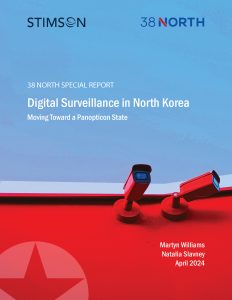Digital Surveillance in North Korea: Moving Toward a Digital Panopticon State
Executive Summary
 Digital technology is progressively entering into different facets of life in the Democratic People’s Republic of Korea (DPRK or North Korea) and reshaping the landscape of its society, especially in Pyongyang. Smartphones can now facilitate electronic payments; set-top boxes offer additional TV and streaming options; cameras keep watch on traffic in major cities; and electronic cards provide access to transportation.
Digital technology is progressively entering into different facets of life in the Democratic People’s Republic of Korea (DPRK or North Korea) and reshaping the landscape of its society, especially in Pyongyang. Smartphones can now facilitate electronic payments; set-top boxes offer additional TV and streaming options; cameras keep watch on traffic in major cities; and electronic cards provide access to transportation.
However, this digital transformation comes at a price: as these technologies continue to roll out, the digital footprint for North Korean citizens becomes larger, and the North Korean state’s ability to gain a deeper insight into people’s lives grows.
North Koreans are already among the most tightly controlled and surveilled people in the world. The state makes numerous demands on their work and free time, limits their ability to move freely within their own country, dictates the media they can consume and restricts their freedom of speech. Citizens are constantly at risk of random or targeted inspections that can involve a complete search of their home or their person.
Much of the country’s existing surveillance network relies on a massive network of human intelligence gathering. From state security agency officials and police all the way down to the workplace administrators and the inminban (인민반) leaders who keep watch on their neighborhoods, some estimates say as many as 1 in 20 North Koreans is part of the existing surveillance system.
The network is large and complex and has served the leadership and Korean Workers’ Party (KWP) for years, keeping citizens under control to the extent that any challenge to authority is almost unheard of.
However, the state is not all-seeing yet. Small spaces exist that allow North Koreans to engage in illicit business activities, consume foreign media and privately criticize the government. The state’s inability to support its citizens means that if caught, people can often offer bribes to escape serious punishment.
The continued adoption of digital technology threatens to erase many of these spaces. A combination of the heavy state control exerted by North Korea and pervasive digital surveillance, such as that carried out in China, could extinguish all but the tiniest freedoms for the North Korean people.
According to our research, North Korea is building surveillance capabilities that reach across various facets of public and private life. While the state may not yet have the capacity to fully utilize all the data it can collect, it is moving towards even greater surveillance of its citizens, enhanced by digital technology.
The move is underpinned by several decades of research into biometric technology. As we outline in the report, facial recognition is in active use in the country, and the state is building a biometric database of citizens that includes photographs and fingerprints.
Facial recognition has the potential to track people wherever they go, and digitization of fingerprints will make the use of fake identification cards difficult or impossible. New video surveillance networks along the country’s northern border could make smuggling difficult, and a road surveillance network is spreading from Pyongyang to other cities.
The wider use of surveillance is not just trained on citizens, but also on the security services themselves—an apparent attempt to make the acceptance of bribes more difficult.
The danger these new technologies pose to the populous is exaggerated in North Korea because, in the absence of a watchdog media, many of its citizens lack a complete understanding of their digital footprint and the ways it could be used against them.
In this report, we look at the North Korean state’s steps further into the digital world and how this is being or might be used for surveillance purposes.
To do this, we examined technology currently in use in North Korea, looked at research on surveillance technologies being undertaken at universities and state organizations, and reviewed domestic and international media coverage of technology. We also conducted interviews with 40 North Korean escapees to get a sense of surveillance when they lived in the country and surveyed 100 current North Korean residents to find out the latest situation and understand their views on digital surveillance.
In our research for this report, we did not spend a lot of time detailing digital surveillance on smartphones, as the area was comprehensively covered in our previous Project Reveal report.
The Korean version of this special report is available here.
